This is an Olympus-35 SP, a 35mm rangefinder camera made by Olympus Optical Co. Ltd., in Tokyo, Japan, between the years 1969 and 1976. When it was released, the 35 SP was one of the most advanced 35mm rangefinder cameras ever built, with features such as dual spot and average metering modes, manual exposure and full programmed Auto Exposure modes. It has a coupled combined image rangefinder, a fast and extremely sharp 7-element Olympus G.Zuiko lens, a multi-slotted film take up spool for easy film loading, and it was built with very high quality control standards. By the time the 35 SP debuted, most new technologies were reserved for new SLR cameras, so fixed lens rangefinders like this generally went down scale and got simpler, allowing the 35 SP to still be one of the most advanced cameras of it’s type ever made, and still highly sought after by collectors and users today.
Film Type: 135 (35mm)
Lens: 42mm f/1.7 Olympus G.Zuiko coated 7-elements in 5-groups
Focus: 2.8 feet / 0.85 meters to Infinity
Viewfinder: Coincident Image Coupled Rangefinder w/ Frame Lines and Parallax Marks, 0.7x Magnification
Shutter: Seiko-FLA Leaf
Speeds (Manual): B, 1 – 1/500 seconds
Speeds (Automatic): 1/15 – 1/250 seconds
Exposure Meter: Coupled CdS Cell w/ Dual 6° Spot / 20° Averaging Metering Mode and Full Programmed AE
Battery: 1.3v PX625 Mercury Battery
Flash Mount: Hot Shoe and M and X Flash Sync, Flashmatic System
Other Features: Self-Timer
Weight: 598 grams
Manual: https://www.cameramanuals.org/olympus_pdf/olympus_35sp.pdf
How these ratings work |
The Olympus-35 SP was the top of the line of Olympus’s full bodied 35mm rangefinder series. Featuring full programmed AE, plus the ability to control exposure manually, an optional spot metering option not often found on rangefinder cameras, and the company’s best 7-element f/1.7 lens, the 35 SP was as impressive on paper as the images it made. This is a very well made camera with good ergonomics and a bright and easy to use camera. It has a very positive reputation for a good reason as it’s one of the best cameras of it’s kind ever made. Highly recommended. | ||||||
| Images | Handling | Features | Viewfinder | Feel & Beauty | History | Age | |
| 2 | 2 | 2 | 1 | 2 | 2 | 20% | |
| Bonus | +1 for almost perfection among fixed lens rangefinders, the best of the best | ||||||
| Final Score | 14.2 | ||||||
History
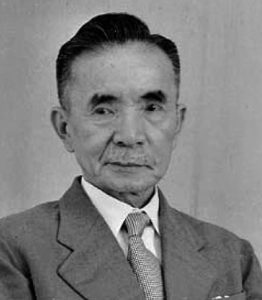
Olympus is one of the oldest Japanese optics companies, being formed before Canon, Minolta, and Asahi (Pentax). The company was founded in Tokyo, Japan on October 12, 1919 as K.K. Takachiho Seisakusho, or Takachiho Works Co., Ltd. in English by Yamashita Takeshi. Mr. Yamashita had previously worked for an industrial manufacturing company known as Tokiwa Shōkai who operated in many Japanese industries at the time.
Takachiho Seisakusho was formed using financial support from Tokiwa who maintained a share of the new company’s ownership and handled all of the company’s marketing.
Although Japan’s industry was growing quickly in the early part of the 20th century, it still relied heavily on many imported products from Europe and other parts of the world. Takachiho Seisakusho’s first products were microscopes and thermometers based on German designs of the time. An early goal of the company was to compete with the likes of Leitz and Zeiss who up until this point had gone unchallenged in these industries.
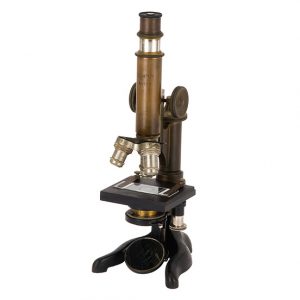
Takachiho Seisakusho would release the first Japanese made microscope in March 1920. It was given the name “Asahi” which stands for “morning sun” which is the symbol of the Japanese people. The Asahi was made with a gunmetal body, and sold for 125 yen. The Asahi was sold under the brand name Tokiwa in 1920, but the very next year, the brand name was changed to Olympus. In total, Takachiho Seisakusho had 7 different models available for a variety of industries, one of the biggest of which was the Japanese textile industry. Tokiwa/Olympus microscopes were very successful, and a source of pride for the company and all of Japan.
The company would continue to improve and innovate new microscope designs throughout the rest of the 1920s and well into the 30s where the Olympus brand became known worldwide as a leader in microscope and optical design.
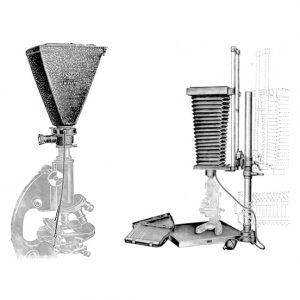
In 1933, Takachiho would sign an agreement with the Japanese Navy as an exclusive maker of microscopes and other optical equipment. One of their products was a device called the Olympus PM I and II which allowed photographs to be taken through a microscope. It wasn’t exactly a camera by traditional standards, rather an apparatus that consisted of a prism, a ground glass, a rudimentary shutter, and a dark box. It would make plate film exposures that were 56mm x 93mm. A later version of this apparatus used a bellows instead of a dark box.
Perhaps due to the success, or at least some level of interest, in this rudimentary microscope camera, in 1935 Takachiho would diversity it’s portfolio by developing it’s own optical lenses. Initially operated as a separate, but co-owned company known as Mizuho Kōgaku Kenkyūjo, the company’s first lenses were released in 1936 and were based off Zeiss Tessar formulas and came in focal lengths of 105mm and 75mm. These lenses were given the name Zuiko as a result of a contest among company employees to select a name.
Mizuho’s original intent was to market and sell their lenses as stand alone products, but could not find any interested parties to buy them. In an effort to drum up interest in their lenses, Mizuho decided to sell the lenses together with a camera body to increase interest in their design.
Without any actual expertise in developing camera bodies or shutters, Takachiho would partner with Miyazaki Shizuma who was the owner of yet another Japanese optics company called Proud-Sha and would use a model they made called the Semi-Proud, a 6cm x 4.5cm folding camera that itself was based of the German made Balda Baldax.

As a result, in 1936 Takachiho would package it’s own Zuiko lenses made by Mizuho Kōgaku, with a camera made by Proud-Sha, and would market it under Takachiho’s Olympus name as the Semi Olympus.
It’s worth mentioning that many Japanese 6cm x 4.5cm folding cameras had the name “Semi”, which is another way of saying “half” for half frame 6cm x 9cm which was the common size for 120 format roll film.
In 1937, Takachiho would release the Semi Olympus II which was inspired heavily by the original Proud-Sha designed Semi Olympus, except this time the body, shutter, and the lenses were all made in house by Takachiho.
It is said that Yamashita Takeshi had a great admiration of Zeiss and wanted to compete with his own quality lenses and cameras. The Zuiko was based off Zeiss’s Tessar formula but was not an identical copy, and the Semi Olympus II was built to compete with the Zeiss Ikonta which was also not an exact copy. Takeshi wanted Takachiho’s products to stand alone in the marketplace and be 100% Japanese designs, and not just another German copy.
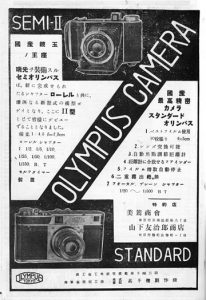
At this time, there was a great deal of innovation in the Japanese camera industry, and Takachiho would design a revolutionary new 35mm rangefinder known as the Olympus Standard, which was going to compete with the Zeiss Contax rangefinder, but the complexity of the design and the onset of war caused production of the Standard to be halted after only 10 prototypes were made.
World War II changed the entire Japanese optics industry, including Takachiho who fell under control of another Japanese optics company called Ataka Shōkai in 1942. Founder and CEO Yamashita Takeshi would resign in 1943 and the company’s name would be changed to Takachiho Kōgaku Kōgyō K.K. From 1940 – 45, the only model being made was the Olympus Six, a 6cm x 6cm folding camera which was also made for the Japanese military.
Then in 1945, several of Takachiho’s factories, including one in Hatagaya where Takachiho’s shutters were made, were destroyed by US bombers, halting production for at least a year. Production of the Olympus Six resumed in 1946, and then in 1948, the Olympus 35 would be introduced which was the company’s first ever 35mm film camera.
On January 1, 1949, the company’s name would be changed once again to Olympus Kōgaku Kōgyō K.K. which was the first time the company was officially known as Olympus.
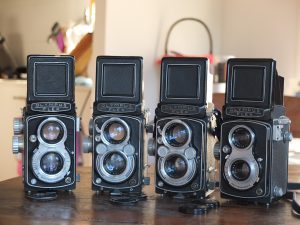
In the 1950s, Olympus would release a wide variety of folding, TLR, and solid bodied full frame and half frame 35mm cameras that were highly successful. At the time, Olympus was one of Japan’s premiere optics companies. Despite their recent popularity as a maker of cameras and lenses, the company would continue to follow in the footsteps of the original Takachiho’s reputation as a quality microscope maker. Many of the company’s most successful microscopes were designed during this period elevating their reputation as one of the world’s leading microscope makers, a reputation the company still has to this very day.
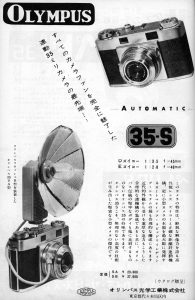
By the mid 1950s, companies like Chiyoda Kogaku (Minolta), Konishiroku (Konica), and Kuribayashi (Petri) all started to enter the world of 35mm. Already dominated by a large number of German models and high end rangefinders by Canon, Nicca, and Nippon Kogaku (Nikon), each of these companies tried their hand at mid level fixed lens rangefinders.
In 1955, Olympus’s first 35mm rangefinder model, the 35S made it’s debut with a cleanly designed and attractive body. It was one of the first Japanese cameras to have a film advance lever instead of a knob, and came with one of the company’s good four element D.Zuiko lenses.
Two years later, the 35 S evolved into the 35 S-II which added a bright frame finder, and was the first Olympus camera to come with the company’s seven element G.Zuiko lens. Available in both f/2 and f/1.8 speeds, the Olympus 35 S-II raised the bar for fixed lens rangefinders which would see them competing with a number of other companies like Mamiya, Yashica, and others.
In 1958, Olympus would release a new camera called the Olympus Auto which added a light meter to the same basic body of the S-II, but despite the use of the word ‘auto’ was not yet capable of fully automatic exposure.

That would not happen for another two years when in 1960, the Olympus Auto Eye would be released. Although it was not the first ever auto exposure camera, upon it’s release it was one of the most advanced. Featuring a full range of flash synchronized shutter speeds from 1 – 1/500, a combined coincident image coupled rangefinder with automatic parallax correction, an aperture readout in the viewfinder, and once again the company’s fast seven element G.Zuiko lens, the Olympus Auto Eye was a technological marvel. It would also debut a familiar body design that would be shared in later Olympus rangefinder cameras released over the next decade.
Fun Fact: Did you know that the letter in front of the word “Zuiko” on Olympus lenses indicates the number of elements it has? Each letter corresponds with it’s order in the alphabet, so D.Zuiko means 4 elements, E.Zuiko is 5 elements, F.Zuiko is 6 elements, and so on.
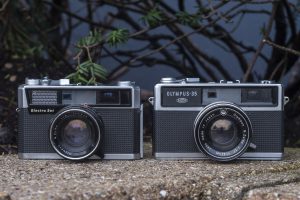
The formula that Olympus used with the Auto Eye would be tweaked throughout the rest of the decade with small revisions in a number of models including the Olympus S and SC, Electro Set, the 35 LE, 35 LC, 35 SP, 35 UC, and finally the 35 SPn. All cameras shared a similar body, lens, leaf shutter (the LE would use a simpler 2-blade shutter) and would have some form of metering.
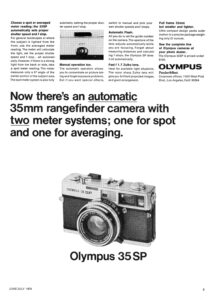
As each new model in the series was released, the list of features grew, culminating in what would become Olympus’s top of the line fixed lens rangefinder, the 35 SP. Released in 1969, the Olympus-35 SP retained the 7-element G.Zuiko of earlier models, but added two state of the art features, one of which had never before been seen in a fixed lens 35mm rangefinder, full programmed automatic exposure and a dual 6° spot / 20° averaging metering mode.
Although a great number of auto exposure “electric eye” cameras had been on the market before the Olympus-35 SP, they would usually have aperture priority, or most commonly, shutter priority auto exposure. Minolta would beat Olympus to the market with a fully automatic rangefinder in the Minolta Hi-Matic 7s, but it was still an uncommon feature, and no camera had the option for a spot metering mode before.
Spot metering was especially tricky for cameras of the era especially rangefinders as the viewfinder does not show exactly what will be captured through the lens. While a certain amount of parallax error was to be expected with any rangefinder, to accurately measure exposure only in the very center of a frame that while looking through it, isn’t the same as what will be captured on film was a challenge that no one else besides Olympus wanted to undertake.
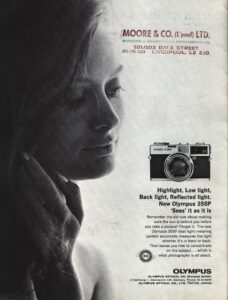
In addition to these features, Olympus also included the ability to take a meter reading in manual mode, which was another feature that few rangefinders (and some SLRs) of the era couldn’t do. On many cameras, putting the camera in manual exposure mode, disabled the meter.
The Olympus 35 SP had a retail price of $99.95 in 1970, which when adjusted for inflation, compares to $765 today, making it a pretty well equipped camera for the money. In today’s market, it would compare favorably to an entry level digital mirrorless camera.
In the two articles below from August 1969 (First Look) and October 1970 (Modern Tests), the dual spot and averaging meter and full auto exposure modes are covered heavily, remaking at their usefulness and simplicity. When looking through the viewfinder, the spot metering mode takes a reading from the area in the viewfinder that the rangefinder patch covers. So if you want to take a reading on a lightly light face in front of a dark background, make sure the rangefinder patch covers the person’s face, lock in your reading by half-pressing the shutter release, hold it, recompose your image, and then press the shutter release the rest of the way.
In the Modern Tests article, the accuracy of both the averaging and spot meters were compared to that of a calibrated external meter, and variances were less than 1/3 stop in average mode and 2/3 of a stop in spot meter. The articles both give high praise to the quality, simplicity, and usefulness of the SP. In the Modern Tests article, it lists a couple nit picks such as the lack of something less than full programmed auto exposure mode or automatic parallax correction, but clarifies that for the price, the lack of these features was not a problem for them
The following Sales Manual for the Olympus-35 SP has been scanned and is courtesy of Pacific Rim Camera’s Reference Library.
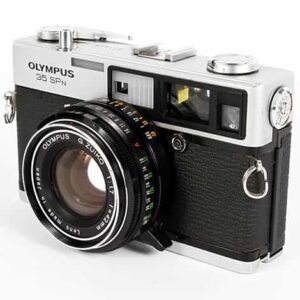
The original Olympus-35 SP was available in both chrome and black with the black body versions being far less common. In 1972, an updated version of the camera called the Olympus 35 SPn (with the ‘n’ stylized as a capital letter, but in a smaller size than the rest of the logo). The only significant change to the new version was an new battery check button and light on the back of the camera allowing the user to confirm the battery had sufficient charge before shooting. Other cosmetic changes were a slightly larger diameter rewind lever, film advance lever with a different contour, black trim around the rangefinder and viewfinder window and a black aperture ring around the lens, instead of chrome.
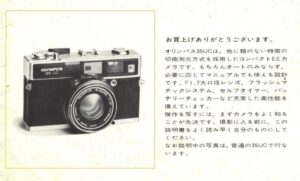
Unlike the regular 35 SP, the 35 SPn was only available in chrome, but one additional variant of the camera called the Olympus 35 UC was released, which changes the entire front plate to black with the body staying chrome but is otherwise identical to the 35 SPn.
The Olympus 35 SPn is far less common than the original model and the Olympus 35 UC is even rarer still. As best as I can tell, the UC was only available for sale in Japan, and it is unclear why it was made, or what the letters “UC” stand for.
Olympus would continue making rangefinders after the SP, however they would increasingly be simpler models, usually featuring auto exposure only operation and smaller bodies with slower f/2.8 lenses. Scale focus models like the Olympus Trip 35 and some models in the Pen series would also outlast the era of the premium fixed lens rangefinder.
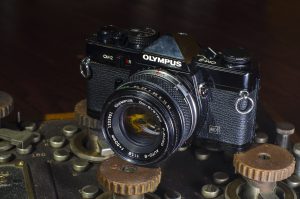
Starting with the release of the Olympus M-1, which would quickly be renamed the OM-1, Olympus would shift their focus as a SLR maker, ending the era of the Olympus rangefinder. As the rangefinder era passed, Olympus would become a major player in the point and shoot market, offering a huge range of models from the most consumer friendly to premium point and shoot models.
Over the course of the next decade and a half, Olympus would enjoy moderate success of their OM-series, but would stumble in the auto focus era. The company’s first attempt at an auto focus SLR, the OM-707 was a failure. This would result in Olympus making their last SLR in 1991. After that the company was solely a point and shoot company. A somewhat successful series of “bridge” cameras called the IS series would hold it’s own until the digital era, in which Olympus would partner with Panasonic to develop digital cameras using the “Four-Thirds” system. Olympus would make a large range of digital point and shoot and interchangeable lens digital cameras until 2020 when the company would sell off it’s imaging business, officially ending the era of Olympus as a camera maker.
Today, Olympus still enjoys a positive reputation among collectors and users of it’s 1960s and 70s rangefinder and SLR models. The Olympus-35 SP is a highly desirable model today, for the same reason it was in 1969, high build quality, a great lens, and an unusual combination of features. Zuiko lenses are known to be as sharp as any other Japanese or German A-list lens maker, and as such cameras with Zuiko lenses are capable of wonderful results for those who shoot film. The Olympus-35 SP is a worthwhile camera to own for many reasons, but if all you want is a rangefinder with an excellent 7-element Zuiko lens, there are cheaper options.
My Thoughts
In the subgenre of 1960s and 70s Japanese fixed lens 35mm rangefinder cameras, there are generally two sizes, large and compact. As the years went by and cameras got more automation, space saving electronics allowed the companies to build smaller cameras. Comparing something like a Konica Auto S3 to the original Konica Auto S, and you’ll see a significant reduction in size. Canon’s Canonet rangefinders also saw a decrease from the original Canonet 19 to the later Canonet QL17 G-III. Yashica’s earlier Minister and Lynx rangefinders shrunk with later models like the Electro 35 CC.

The Olympus 35 SP is firmly in the “in between” size in which it is neither as large as, nor as small as all the cameras I just mentioned. When placed side by side with a camera like the Yashica Electro 35 or even an earlier Olympus 35 LC, the camera is marginally shorter, but quite a bit narrower side to side. It is not as small as a Konica Auto S3 or Canonet QL17 GIII, but is nearly identical in size to a Petri 1.9 Color Corrected Super. It’s weight, at 598 grams is between 50 and 100 grams lighter than most of those models as well.
This gives the overall dimensions of the camera the reassurance of a larger body but also an increased sense of portability where you might be able to fit it into a medium coat pocket or small handbag without it’s corners getting caught on something.
The Olympus-35 SP is a handsome camera with a somewhat busy front. A rectangular window above the logo illuminates the meter readout in the viewfinder, a larger frosted window around the rangefinder window illuminates the frame lines, then there’s the main viewfinder opening, and to it’s right is the CdS Exposure meter.
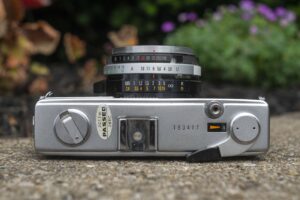
Up top, the Olympus-35 SP looks like any other camera from it’s era. On the left is the rewind knob with fold out handle for easier rewinding. The knob does not lift up for film loading however. In the middle is the flash hot shoe which is synced at all speeds. Next is the serial number and automatic resetting exposure counter which look like they were lifted straight off some kind of “Olympus Camera Design Board” as they resemble the ones on other cameras like the Trip 35 and Pen F SLR. Above the exposure counter is the cable threaded shutter release button, and finally the film advance lever. The film advance lever is easy to move and has a fast 120 degree throw making getting to the next shot quick and easy.
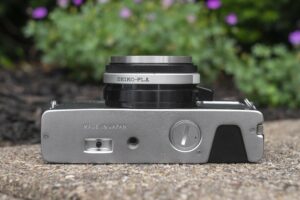
The bottom of the camera has the rewind release button. 1/4″ tripod socket, and the round opening for the PX625 battery compartment. As was typical of cameras from this era, the Olympus 35 SP uses 1.35v Mercury batteries, and as best as I can tell, there is no stepping circuit in the camera, meaning that putting in a modern 1.5v alkaline battery will over-power the meter, resulting in incorrect readings.
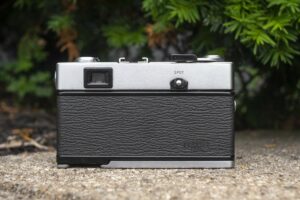
Around back is the rectangle eyepiece for the viewfinder. The location of the viewfinder is perfect for right eye shooters who want to use both eyes while shooting, and for left eye shooters because it is far enough away from the film advance lever that you can advance film with the camera to your eye and not poke your forehead.
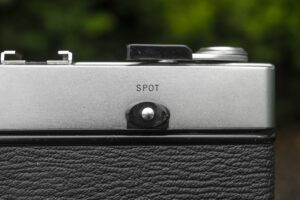
Opposite of the viewfinder is a chrome and black button for activating the 6° spot metering mode. Without this button pressed, the meter functions in a normal average metering mode which covers an approximate 20° angle of the viewable image in the viewfinder. This works like any other metered camera of the era in which light and dark extremes is averaged out for an exposure reading. For instances where one part of your image is strongly bright or darker than rest and you want the camera to take a reading from one of those extremes, the spot meter function is ideal.
Lets say you had an object in front of a bright window and you intentionally wanted to meter for the light so that you capture just an outline of the object. While pressing and holding the button, move the rangefinder patch of the viewfinder to the bright window and half press the shutter release to take a reading. Assuming you agree with the reading, while still holding the shutter release button half way down, recompose your shot to include the silhouette, and then press the shutter release. Likewise, if you had a front lit object in front of a brighter window and you wanted to meter for the front object, do the same thing, except take the reading on the object you want to be correctly metered.
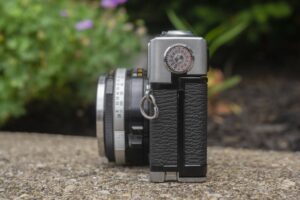
The camera’s left side has both a dial for setting the film speed for the exposure meter and a small latch near the bottom for unlocking the film compartment door. The film speed dial has readings in both ASA and DIN from 25 to 800 and 15 to 30.
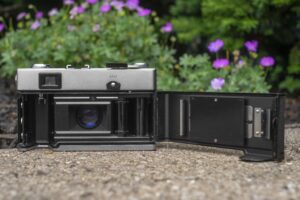
The right hinged film door opens to reveal the film compartment. Film transports from left to right onto a plastic and multi-slotted take up spool. The design of the spool allows for easy film loading as you can simply insert a new leader anywhere in the spool without having to center it. On the cassette side, there is no need to lift up on the rewind fork as a notch in the bottom of the film compartment allows you to slide in the film cassette from the bottom. Although not technically a “Quick Load” film system, the one on the Olympus-35 SP is well thought out and very easy to use.
On the inside of the door is a large and dimpled film pressure plate with a clip on one side and a metal roller on the other, all of which help maintain film flatness and reduce friction as film passes through the camera. The film compartment originally had foam light seals which have degraded over time. For anyone picking up one of these cameras today, you will want to replace them before shooting film in the camera to prevent light leaks.
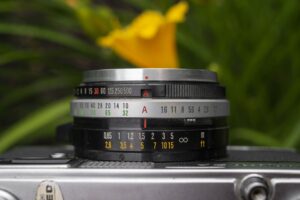
Keeping with the midlevel size of it’s body, the Seiko-FLA shutter is neither too deep, nor too shallow. It is deep enough to have rings for focus closest to the body, apertures from f/1.7 to f/16, and shutter speeds from 1 to 1/500 plus Bulb. Both the shutter speed and aperture rings have click stops and are not coupled together, so there is no confusing LV coupling to get in the way. If you so wish however, both rings are close enough together that you can grip both at the same time and make corresponding changes to both if you so wish.
Fun Fact: The aperture ring on the Olympus-35 SP has a minimum setting of f/16, the user manual and all documentation for the camera says in auto exposure mode, the camera can stop the lens down to f/22.
Although the Olympus 35 SP supports full programmed automatic exposure and is designed to be easy to use, setting it does require a bit of explanation. Unlike most AE equipped cameras in which there is just a single setting to put the camera in Auto mode, the 35 SP has two. In order to put the camera in AE mode, you must first turn the aperture ring to a red A setting and then also rotate the shutter speed so that a second red A shows through a small window to the right of the 500 setting. Only with both rings set to A is the camera in AE mode.
The small window on the shutter speed dial also serves a second purpose. When not in Auto mode, the small window reveals an EV scale beneath showing the EV number that corresponds to whatever combination of shutter speed and f/stop you have selected. This is important to know when shooting in manual exposure mode as the meter display in the viewfinder only shows EV numbers. So for example, if in manual exposure mode, the meter needle is pointed at EV 13, selecting 1/125 and f/8 will result in an exposure value of 13, and therefore the correct exposure. As I type this, it sounds confusing, but trust me, whatever the number the meter says, if you see the same EV number on the shutter, you’ll get correct exposures.

The Olympus-35 SP features a lot of technology which allows it to stand above other rangefinders of it’s era, but one area in which Olympus chose not to deviate from the norm is in the viewfinder. Peering through the rectangular eye piece is a rather ordinary viewfinder. Brightness is on par with nearly every other Japanese rangefinder camera of the 1960s with a slightly blue viewfinder with a rectangular rangefinder patch in the middle and projected frame lines around the edges. The frame lines do not automatically correct for parallax, so when at minimum focus, you must rely on parallax correction marks. The frame lines themselves are near the extreme edge of what can be seen while wearing prescription glasses. I had to press my face uncomfortably close to the back of the camera to see all four sides at once.
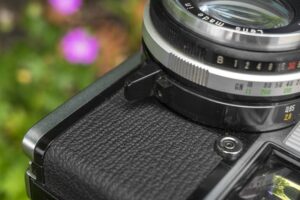
Above the top frame line is the meter read out scale, which I explained earlier which shows EV numbers. The scale goes from 17 down to 3, but the numbers 8 and below have a yellow background to warn you that a slow shutter speed will be used, and that you should stabilize the camera to prevent shake. In full Auto Exposure mode, if the detected amount of light is too far above or below the range the camera can adjust for, the shutter release becomes locked and you cannot fire until the exposure is within range of what the camera can accommodate.
The Olympus-35 SP was not only Olympus’s highest spec rangefinder, it was one of the most advanced fixed lens rangefinders ever made by any company. By 1969 when the camera was released, a bulk of new technologies were being invested in SLRs, and the market for high end rangefinders was almost completely gone. Had SLRs not been as popular, it stands to reason that this style of camera would have continued to get more advanced. Who knows what a premium fixed lens rangefinder with a full PSAM dial, electronic motor drive, or even auto focus might have been like.
History tells us that the Olympus-35 SP was a special camera and is still very popular among collectors and users today, but is it’s reputation deserved? What is it like to shoot? Keep reading…
My Results
You would think that after over eight years of writing camera reviews and shooting countless old cameras, there would be some lessons I would have learned by now. One of those lessons is to inspect and replace light seals before putting any film into an old camera that is new to me. I often mention in my reviews if a camera has a light seal which should be replaced before using and I even have a section on replacing light seals in my Breathing New Life Into Old Cameras article, so this is something I have a lot of knowledge of.
Apparently, I need to read my own articles as on occasion I don’t follow my own advice. One such example is with this Olympus-35 SP. When the camera came to me, I was so excited to use it and had a quick trip to downtown Chicago scheduled, I quickly loaded in some bulk Kodak TMax 100 and shot it. As you might guess, the light seals were degraded and the entire roll had light leaks.
In an effort to use myself as a cautionary tale, plus also show what the camera is still capable of even with rotted light seals, here are some images from that first roll.
Realizing that I needed to take care of the light seals before giving this camera another go, I took the time to replace the rotted seals along the door hinge and along the film channels. After this was done, I took the camera out for a second roll in early 2023 just as it was starting to warm up. For this roll, I used a fresh roll of Fuji 200. As I would later find out, my series of poor choices continued after I completed the roll as I pushed the life of my C41 chemicals with this roll, as the colors show a noticeable shift, directly as a result of the exhausted chemicals, but I in no way fault the camera for that.
Poor decisions on my end aside, the best decision I made was shooting the camera in the first place. Olympus rangefinders really don’t need a lengthy review from some blogger to tell you that they are well renowned for making excellent images. The 7-element Zuiko lenses in this, and Olympus’s earlier full body 35mm rangefinders produce extremely sharp images. In terms of sharpness and clarity, I feel confident saying that these stand up to any A-list SLR, rangefinder, or any other type of 35mm camera ever made, it’s that good.
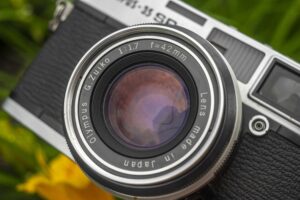
Sharpness is excellent corner to corner, and there is little to no vignetting or softness in the corners. The interior shot of the soccer goal does show darkness around the corners, but I attribute that more to the lighting in the arena, rather than lens performance. Although I shot that one wide open, so it’s possible the camera contributed somewhat, but aside from that one image, I found absolutely no faults or other optical anomalies often present in cameras with lesser lenses.
Of the two metering modes available for the 35 SP, I mostly shot using the averaging meter, but purposely tried the spot meter a couple of times. The need for a spot meter is when lighting changes dramatically in different parts of your image, like for example if someone is standing in front of a brightly lit window or an image where one half is much brighter or darker than another and you want to pick which part of the image should be metered. I find that the style of images I shoot usually don’t require this feature, even on SLRs where it is more common, but still, to have it on a rangefinder is cool, and using the rangefinder patch as my area to where the reading is taken from was a good choice by Olympus.
The Olympus-35 SP is a very popular rangefinder camera for good reason as it represents the furthest in development fixed lens 35mm rangefinder cameras went before companies abandoned the format for SLRs and simpler cameras. While many companies, Olympus included, would make rangefinder cameras after the 35 SP, they increasingly added automation and lost manual control and other advanced features coveted by rangefinder enthusiasts. Although the 35 SP has a good amount of automation, it still allows full manual control of exposure which is great not only for those who want manual control, but with the likelihood that you could find one with a dead meter, the camera is still fully usable unlike many other cameras like the Yashica Electro which don’t work without power or the meter. By far, one of the coolest features of the camera is the spot meter mode, which allows you to take a meter reading only in the space occupied by the rangefinder patch. Spot metering was a popular feature on SLRs, but finding a rangefinder that could do it was a challenge.
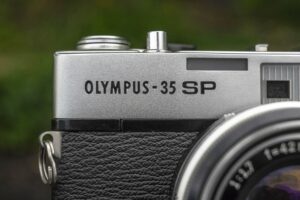
The Olympus-35 SP is a really great camera that is almost perfect. While the option for full programmed AE is nice, that you cannot step down to either aperture priority or shutter priority seems like a missed opportunity. If I wanted a camera that could do both AE and manual exposure, I usually like to still have some partial control.
Another nitpick is that it’s reliance on EV numbers in the viewfinder display is a bit of a disappointment as it requires you to look at the EV number, then change combinations of f/stops and shutter speeds until a matching EV number shows in a small window around the lens. It’s not impossible to use, but is definitely slow and likely something most people just didn’t bother with.
One final nitpick is the location of the meter cell to the left (from the photographer’s side) of the viewfinder is very near where your left hand would be while shooting so it’s possible to block part of or all of the meter while taking a reading. In addition, the meter’s location outside of the filter ring means that using colored or neutral density filters requires a filter conversion as the meter can’t see it. For what Olympus had hoped would be a premium rangefinder, simply relocating the meter to the lens and using f/stops instead of EV numbers in the viewfinder would have made the camera more flexible.
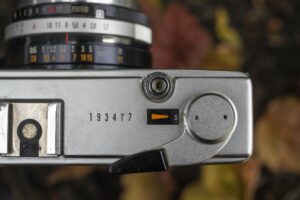
Those minor nitpicks aside, a well built and highly featured 35mm rangefinder with good ergonomics, automatic exposure along with an option for full manual control, and one of the sharpest 7-element lenses ever found in a 35mm camera make for an excellent combination. Many people online and in written magazines of the past have heaped a lot of praise on the Olympus-35 SP, and there’s nothing I experienced to suggest they were wrong. This is a fantastic camera that is a lot of fun to shoot and it makes awesome photos.
One tip that I’ll suggest is that if you don’t care about spot metering or automatic exposure, and just want a good rangefinder with an excellent 7-element lens, Olympus did use this same (or at least very similar) lens in some of their other rangefinder models like the Olympus-35 LC and Electro Set. If you can find one of those cameras, you’re likely to get the same quality images, but at a much lower cost.
Related Posts You Might Enjoy
External Links
http://camera-wiki.org/wiki/Olympus_35_SP
https://casualphotophile.com/2019/08/16/olympus-35-sp-review/
https://emulsive.org/reviews/camera-reviews/olympus-35-sp-by-matt-parry
https://photojottings.com/olympus-35-sp-review/
http://www.alexluyckx.com/blog/2016/01/27/ccr-review-29-olympus-35sp/
https://cjo.info/classic-cameras/olympus-35-sp/
https://schneidan.com/2014/01/15/review-photos-olympus-35sp-35mm-rangefinder-camera/
https://www.lucianacouto.com/olympus-35sp-review-and-sample-photos/

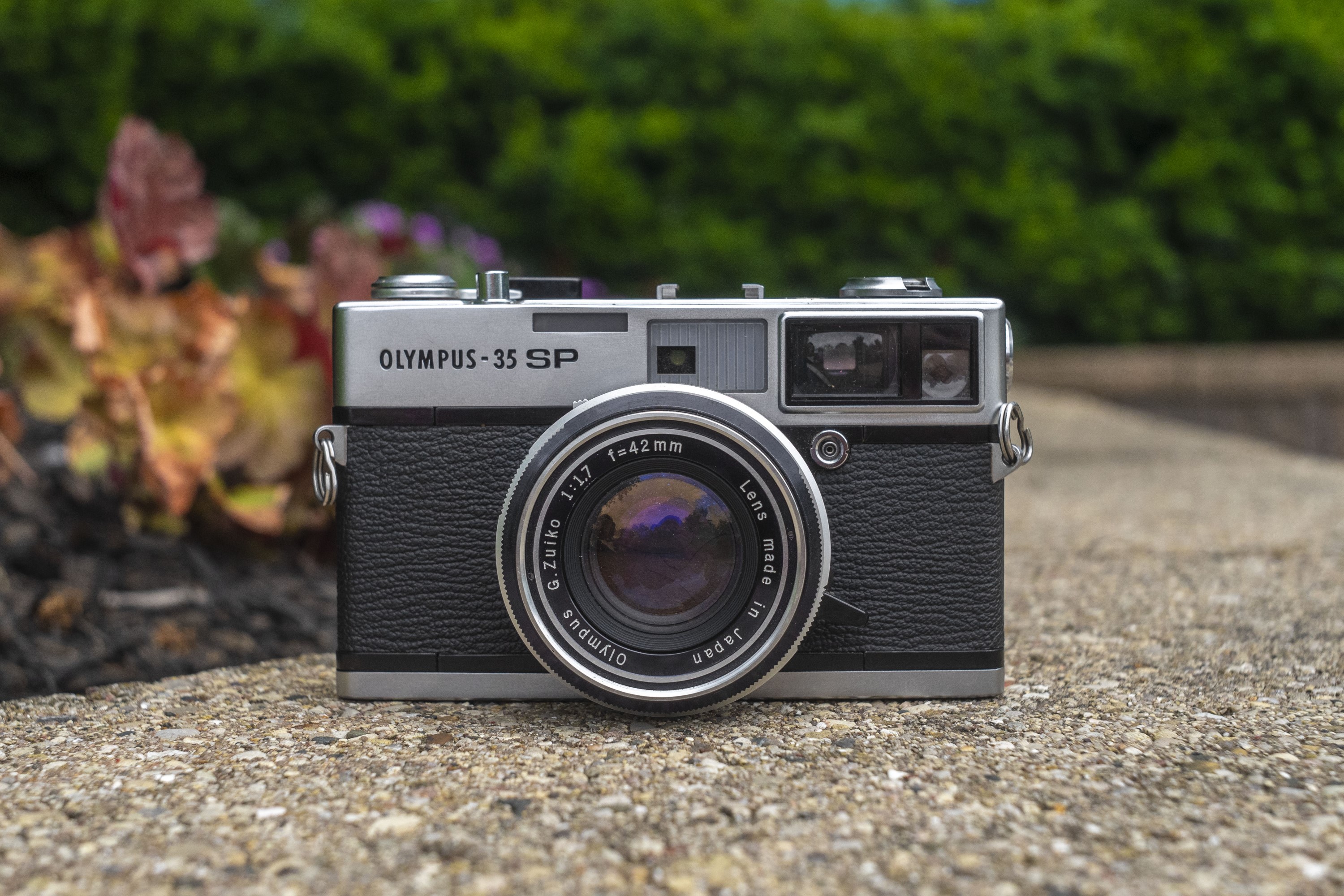
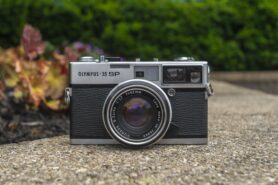
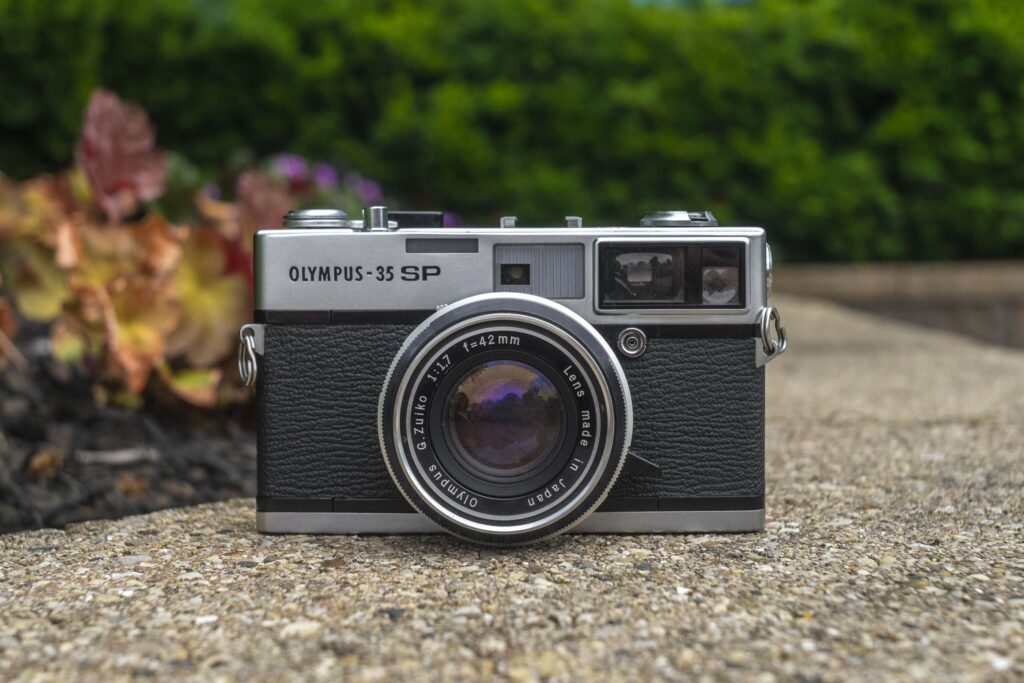



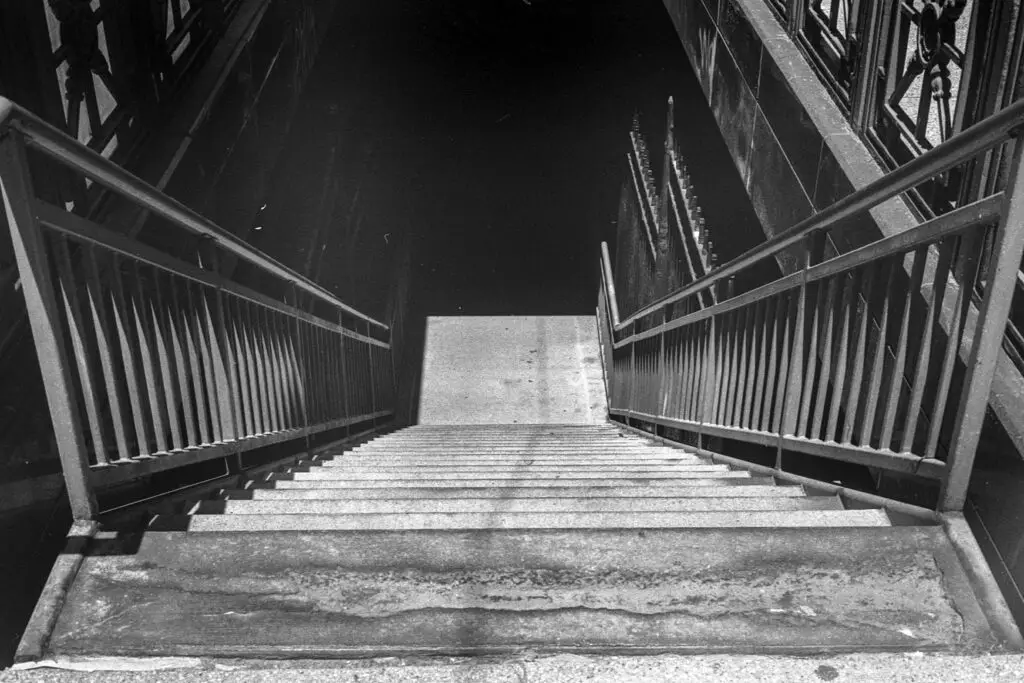

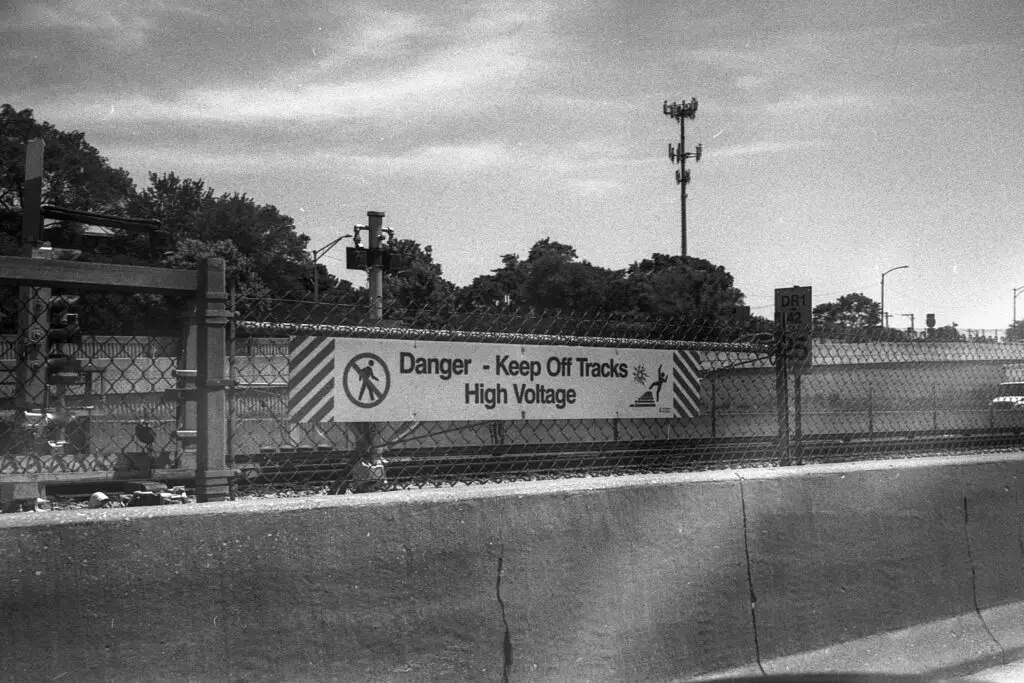


















Great review of a great camera. The lens on the SP is razor sharp. I love everything about this camera. Although today Olympus is perhaps best known for the excellent OM system I believe their rangefinders is where they excelled the most.
Agreed with everything you said! The SP is a wonderful camera! I just wish people were more aware of their earlier rangefinders too!
A very good review Mike! I purchased my 35SP many years ago, the lens immediately impressed me in terms of sharpness, which made me really curious to see the resolution&contrast data (e.g. lpmm) but I can not find them anywhere. Although coating, color rendition and bokehs shows drawbacks, the G. Zuiko is still a very good lens. My personal complain about this camera would be around the body – the rectangular box shape body makes 35SP aesthetically appealing, but sometimes uncomfortable to hold in the hands. Strap lugs are located in the front, which let the camera lean backward and sometimes makes my waist feels uncomfortable (I guess this design is a compromise, otherwise the ASA dial will be affected by the strap).